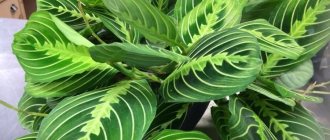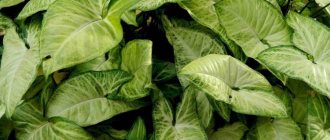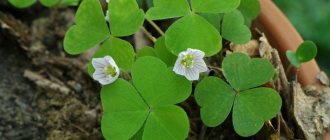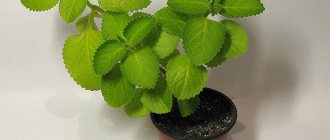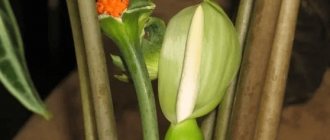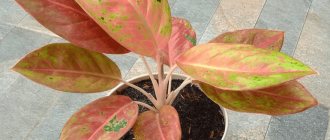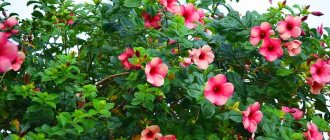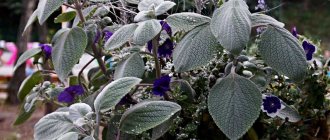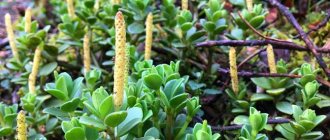Author: Elena N. https://floristics.info/ru/index.php?option=com_contact&view=contact&id=19 Category: Houseplants Published: January 20, 2019Last edits: January 11, 2021
- Dividing the bush
- Stromantha is drying
- Stromanthe amabilis
Stromanta is a plant with very beautiful leaves, a relative of arrowroot, ctenantha and calathea. The difficulty of keeping stromanta at home is that it requires high air humidity, and creating such conditions can be difficult, especially in winter, when heating devices are operating at full power. But for Stromantha admirers such difficulties are not an obstacle; they are ready to make sacrifices so that the beautiful Stromantha leaves do not lose their attractiveness.
- How to find a comfortable corner for stromanta?
- How to create optimal conditions for a plant?
- How to care for stromanta during the season of active growth and during the dormant period?
Our article answers all these questions.
Planting and caring for stromanta
- Flowering: grown as an ornamental foliage plant.
- Lighting: bright diffused light, light partial shade.
- Temperature: during the period of active growth - within 22-25 ˚C, in winter cooler conditions are needed, but the temperature should not fall below 18 ˚C.
- Watering: in the warm season - regular and plentiful, in winter - moderate to meager.
- Air humidity: very high - about 90%: daily numerous sprayings of leaves, periodic shower procedures and keeping the plant on a tray with wet pebbles are recommended. You can line the pot with moss and constantly moisten it.
- Feeding: from May to August - twice a month with complex fertilizer for decorative deciduous plants in half the dosage.
- Dormant period: not clearly expressed, but it is advisable to give the plant a rest in winter.
- Transplantation: at the end of spring using the transshipment method. Young plants are replanted annually, adults - once every 2-3 years. If you do not want to disturb the plant, simply replace the top 5 cm of substrate in the pot.
- Reproduction: by dividing the bush or by apical cuttings.
- Pests: aphids, thrips, whiteflies, mealybugs and scale insects.
- Diseases: all manifestations of ill health are associated mainly with poor care and violation of living conditions.
Read more about growing stromanta below.
plant (lat. Stromanthe) belongs to the genus of the Marantaceae family, like calathea and arrowroot itself. Various sources of information report that from five to fifteen species of Stromantha grow in nature - the problem is that it is very easy to confuse it with its related Calathea and Ctenantha, and some taxonomists do not distinguish Stromantha as a separate species at all, but classify it as a member of the genus Calathea . Stromantha is native to the tropical rainforests of South America.
Transfer
Indoor specimens initially require annual replanting, and with age they can “live” in one pot for 2-3 years. In order to minimize trauma to the root system, replanting is carried out by transshipment, preserving the earthen ball and filling the voids with new soil. Also, if possible, you should try to replace the entire top layer of soil.
Earth mixture
For cultivation, you need loose, light, humus soil with excellent aeration characteristics and a slightly acidic acidity level within pH=6. It is advisable to include humus, sand and peat in its composition, using turf soil as a basis. At specialized points of sale there is a special soil mixture for growing arrowroot; you can also use a composition for palm trees. It will be useful to add a little lump charcoal and sphagnum or other moss to any soil.
The height of the drainage layer should be about a quarter of the height of the pot.
Features of cultivation
The stromanthus flower is a herbaceous perennial, reaching one meter in height in nature. The main advantage of the plant is its very beautiful large leaves, up to 50 cm in length and up to 10 cm in width, painted in cream, pink, white and green colors in all sorts of combinations. The leaves are connected to the petioles by such an articulation that allows them to turn towards the light source, in whatever direction it may be.
- Hornwort: keeping in an aquarium, types and photos
Stromantha has the same feature as all arrowroots - its leaves fold and rise up in the evening and open, descending, in the morning. For this reason, all arrowroot plants, including stromanthus, are called praying plants.
The indoor stromanthus plant is very demanding to care for, and this often repels those who want to purchase it. Nevertheless, such a task as growing stromanthus can be easily accomplished if you understand the nature of this plant. In its natural habitat, stromantha grows along the banks of reservoirs, where the South American climate is always warm and damp, and the soils are loose and breathable. Stromanta grows in the forest at a level where direct rays of the sun almost never reach due to the closeness of the crowns of tall trees, so the plant is content with bright but diffused light. However, the duration of daylight hours in those latitudes is longer than in our climate zone.
Based on these characteristics, conditions should be created under which an indoor stromanthus flower will feel at home. The best place for small species of stromanthus is in terrariums, and for large ones you can create the necessary conditions on the windowsill.
general description
Stromantha is one of the representatives of the Maranthaceae family, which is interesting and quite difficult to cultivate at home. The closest relatives are calathea, ctenanta and arrowroot itself. Their appearance and structure are very similar, which is why they are often confused with each other. According to some taxonomists, these plants are not even divided into a separate generic classification.
The birthplace of the culture is the tropical rainforests of the South American continent. The large leaves have a bizarre color and grow on tall, erect petioles. At night, they stand upright, hiding their front surface from view. Because they are always facing the source of light, and with the arrival of evening twilight they rise upward, like hands folded in prayer, the flower is nicknamed “praying.” The height of indoor specimens can reach 80 cm. The plant does not have a main stem.
You can distinguish stromanta from calathea by shape and color. Calathea does not have a beet color on the underside, and the shape is more rounded and wider. But in some cases it is very easy to make a mistake; even experienced flower growers make mistakes in identification.
The leaf blade has such a clever connection with the petiole that it can rotate relative to it in different directions, changing its position in the horizontal and vertical plane. All representatives of the Marantaceae family have this botanical feature. Now rising, now falling, now opening completely, now curling up into a tube, the plant is in constant motion. In the complete silence of the tropical forest, where entire thickets of this perennial are formed, and its petioles reach a meter in length, all this movement produces a slight rustling sound, which can be heard especially clearly at dawn and in the evening.
Caring for stromanta at home
Rules of care
Caring for a stromanta will require daily efforts from you. It is best to keep Stromantha flowers at a temperature of 22-25 ºC in the summer, and in winter the temperature should not fall below 18 ºC. Please note that stromanta at home does not tolerate drafts and temperature changes, so be careful with ventilation, eliminate all cracks in window frames and do not move the pot with the plant close to the glass in winter. The soil in the pot should also always be warm.
The lighting will need to be bright, but without direct sunlight. Stromantha is a shade-tolerant plant, but not at all shade-loving, so there must be plenty of light, otherwise the variegation of the multi-colored leaves of the stromantha will be leveled out.
Watering the stromanthus is carried out with soft, settled water at the same temperature as in the room where the plant is kept. In the warm season, the soil of Stromantha is moistened abundantly; in winter, watering is significantly reduced. Air humidity will need to be very high - about 90%. They increase the humidity by numerous daily sprayings of the leaves of the plant and keeping the stromanta on a tray with wet pebbles, expanded clay or crushed stone. You can line the pot with the plant with sphagnum, which should be moistened regularly. From time to time, give your stromante a warm shower.
- Hemanthus at home: care and types
As for fertilizers, from May to August, during the period of active growth, stromantha needs to be fertilized with liquid complex fertilizer for indoor ornamental foliage plants, which should be applied in half the dose recommended by the manufacturers twice a month - stromantha is very sensitive to excess calcium in the soil and minerals, so it’s better to forget to fertilize than to do it more often or in larger doses than necessary.
Transfer
Stromantha transplantation at home is carried out at the end of spring. Young stromanthus are replanted annually, and adult plants - after 2-3 years, using the method of transferring the plant from an old pot to a new one, which makes it possible to injure the root system to a much lesser extent. If you think repotting will harm the plant, you can simply replace the top layer of soil in the pot with fresh soil. The soil for stromanta should be humus, loose, water- and air-permeable, slightly acidic (pH 6), approximately the following composition: three parts of leaf soil, one part of humus, peat and sand.
You can use a ready-made substrate for arrowroot or a Palma substrate, which are sold in flower shops. It would be good to add a little sphagnum and pieces of charcoal to the purchased or self-made soil. Before transplanting the stromanthus, it is necessary to place a layer of drainage material in the stromanthus pot approximately one quarter of its volume.
Stromantha blooming
Stromantha blooms in panicles 6-8 cm in diameter, composed of inconspicuous white flowers with red bracts on long peduncles and orange-red sepals, but at home, stromantha blooms very rarely. But if you satisfy all her whims, then maybe you will be lucky enough to see Stromantha flowers someday.
General information
Stromanta is a perennial ornamental plant from the genus Maranthaceae. The newcomer from the South American continent is distinguished by a spectacular and non-standard appearance. Beautiful, elegantly colored leaves look like stylish decorations or colorful birds. There are about 15 different species of Stromantha, growing mainly in the wild. Only a few of them are used for decorative cultivation.
The height of plants growing indoors does not exceed 100 cm. Due to the low arrangement of branched shoots, it seems that the bush consists only of leaves. They are the most important decorative part of the plant. The leaf has an oval-lanceolate shape and reaches a length of up to 35 cm. The green color of the plate can be of varying saturation. Asymmetrical spots of pink, white, and cream color are scattered over the entire surface of the leaf, depending on the variety. The texture of the leaves is also unusual, reminiscent of satin or velvet.
All types of Stromantha are characterized by the ability to change the position of their leaves in the plane. Thanks to the peculiarities of the petiole, they can turn towards the sun. At the same time, the bush is transformed, becoming emerald-burgundy instead of variegated green and acquiring an unusually elegant appearance. Although the movements of the plant themselves are imperceptible, the amplitude of the leaves during the day is very clearly visible, which gives the flower a resemblance to a living organism.
The unusual behavior of the flower is explained simply. The base of the leaf contains a pigment that can control the position of the leaf blade depending on the intensity of sunlight.
In the evening and morning hours, in order to receive enough light for the process of photosynthesis, stromanthus turns its leaves with their surfaces towards the sun. At midday, when the sun is brighter, turn them edge-on to avoid burns and reduce moisture loss.
For such an interesting feature, Marantaceae representatives are also called “prayer plants.” The leaves, rising vertically, resemble the hands of a person folding during prayer.
In indoor conditions, flowering of stromanthus can be seen in rare cases. The long peduncle covers many small white flowers with bright red bracts. The room is filled with an unusual pleasant aroma.
Such beauty has one drawback - after flowering, the leaves lose their attractiveness. The plant needs a long time to restore its former beauty.
Reproduction of stromanthus
Dividing the bush
It is most convenient to divide a stromanthus bush when replanting the plant. A large plant is divided into 2-3 parts, trying not to injure the roots. Delenki with two or three good roots and several leaves are planted in wide, shallow pots with drainage and an appropriate substrate, then the stromanthus after transplantation is placed in a warm place and tightly sealed under a transparent plastic bag until the plant takes root and produces new leaves.
Propagation by apical cuttings
Propagation of stromanthus by cuttings is also best done in late spring or summer. Apical cuttings 7-10 cm long with two or three leaves are cut from the mother plant so that the cut passes slightly below the attachment of the leaf to the shoot. The cuttings are placed in a container of water, which is covered with a transparent plastic bag to form a mini-greenhouse. The roots grow in approximately five or six weeks, after which the cuttings are planted in pots with a peat-based substrate.
Using fertilizer
During the growing season, Stromantha needs feeding.
But be careful! An increased dosage can destroy a tropical flower. It is better to dilute the fertilizer by half and feed approximately once every 14 days.
Pests and diseases
Stromantha is drying
It often happens that our readers complain that the leaves of Stromanta are drying up. If the tips of the leaves of Stromantha dry out, the cause may be dry air or infection of the plant with spider mites, which is also the result of insufficient air humidity in the room. Spray the leaves of the stromanthus more frequently, keep the pebbles in the tray moist at all times, treat the leaves of the plant with a soapy solution using a sponge and do not wash off the soap for 3-4 hours, and then, after rinsing the stromanthus, place it under a plastic bag to prevent spider mites from there is still a chance to survive.
- Names of pandanus species + photos
If you cannot defeat the tick with soap, use an “armor-piercing” treatment – Actellik. But what to do if the leaves of Stromantha dry out, and before that they also lose color? This means that Stromante does not need so much sunlight: move it to partial shade or shade it from the sun during the midday hours.
Stromantha leaves curl
Stromantha reacts to any violation of the conditions of detention by changing the state of the foliage. Why do stromantha leaves dry out? Why do they curl up and become covered in spots? Because the plant suffers from improper watering. Both in the case of excess moisture in the soil and in the case of insufficient moisture, the leaves of Stromanthus behave in a similar way - they curl and fall off. Remember: the soil of Stromanta should never dry out. But there is no need to spread liquid mud in the roots of the plant.
Stromantha leaves wither
Drooping leaves and rotting stems of stromanthus are the result of high air humidity in a room with a temperature that is not high enough for stromanthus. In this case, leave the air humidity at the same level, and try to increase the temperature in the room to 25-30 ºC.
Pests and their control
In addition to spider mites, thrips, scale insects, mealybugs and whiteflies harm Stromanthe. Whiteflies and thrips are destroyed with the same drug as spider mites - actellik. One ampoule of the drug is dissolved in a liter of water and the plant is thoroughly sprayed with this composition, then a transparent bag is put on the stromanta, which is removed after a day. If the problem cannot be solved at once, repeat the procedure in a week or two.
It is best to destroy aphids with phytoverm or inta-vir, and get rid of mealybugs in this way: dissolve one teaspoon of grated soap (any) in hot water, then add enough water to make one liter in the end, add two tablespoons of vodka, mix and Thoroughly spray the stromanta with this solution, protecting the soil in the pot from soapy water getting into it. After a day, the plant is washed from the solution, also covering the soil so that soapy water does not get into it. Treatment with a soap-vodka solution will have to be repeated every seven days two or three more times. Instead of soap, you can use any dishwashing detergent.
Table: care problems
| Errors | Probable Causes | Correcting the situation |
| The tips of the leaf blades turn yellowish-brown | Excess or lack of nutrients in the soil. |
|
| The leaves become covered with brown spots and then curl into a tube. | The soil is dry. | The soil must be constantly moist. Adjust the watering regime, do not allow the substrate to dry out completely. |
| The leaves lose color and then dry out | Too intense lighting. | Move the container with stromanta to a place with diffused light. The best option would be an east window. |
| Stems become limp | The temperature of keeping stromanthus is lower than recommended, especially in high humidity. | Increase the temperature of the plant. |
| Leaves fall | Dry indoor air. |
|
Types and varieties
In indoor culture, the most popular species have become pleasant stromantha and bloody stromantha.
Stromanthe amabilis
An ornamental deciduous plant reaching a height of 30 cm. Its leaves are long-petiolate and have a regular broad oval shape, from 10 to 20 cm in length and from 4 to 5 cm in width. On the upper side of the leaf plate there is a herringbone pattern - dark green stripes diverging in light -green background from the central vein. The underside is greyish-green with a subtle pink tint. If Stromantha pleasanta blooms, it happens in spring or summer.
Bloody stromantha, or blood-red (Stromanthe sanguinea)
Native to tropical rainforests of Brazil. It is a larger species than Stromantha pleasanta. The leaves of Stromantha bloody are oval, pointed, from 15 to 40 cm in length and from 7 to 13 in width. The top of the leaf is glossy, light green with a V-shaped dark green pattern, the underside of the leaf is a pronounced cherry hue. It blooms closer to summer with inconspicuous white flowers collected in a spike.
Of the most popular varieties of blood-red stromantha, you may like:
- stromanta multicolor - a variety in which the upper side of the leaf blade is dark green with light green and almost white streaks, and the lower side is red-burgundy;
- stromanta horticolor – the upper side of the leaf is yellow-olive-light green, the lower side is dark red;
- stromantha tricolor, or triostar, is the most popular variety form among flower growers, which has a pattern of pink, white, fawn and light green stains on the upper, dark green side of the leaf, with dark burgundy leaves on the bottom;
- variety Maroon - a light green central vein runs along the green upper side of the leaf, the underside, like all varieties of this species, is dark red;
- Stripe Star variety - along the bright green upper side of the leaf plate, right along the central vein, there is a light stripe, the underside of the leaf is burgundy.
Stromanthe sanguinea
It grows up to 50 cm. The shape of the leaves of this plant is oval with pointed edges measuring 15-40 cm. The top of the leaf is light green, on which the image of the “V” sign is visible, the bottom is red.
Blooms from spring to summer with small inflorescences.
Among plants of this species, the following varieties are better known: Tricolor, Multicolor, Maroon and Horticolor.
How to deal with pests?
Despite its capriciousness, stromanta relatively rarely suffers from pests. But prevention cannot be neglected - the flower “departs” from any damage for a long time and painfully.
Common Stromantha pests - table
| Pest | Characteristic symptoms | How to deal with the problem? |
| Spider mite | The tips of the leaves dry out, they themselves curl, and the color fades. The petioles at the junction with the leaf are entangled with thin, almost transparent threads. If measures are not taken, the plant will disappear under a continuous layer of whitish mass. | Good prevention is regular spraying and ultraviolet light. At least once a week, irradiate the leaves on both sides with a quartz lamp for 2–3 minutes. Having found a pest, apply a soap-alcohol solution to the leaves for 30–40 minutes, then take a shower. After 2–3 hours, spray the flower with an acaricide (Fitoverm, Agravertin, Aktofit, Vermitek, Nisoran, Sunmite, Oberon) and, if possible, seal the top with a plastic bag. It is removed after 2–3 days. A minimum of 3 treatments with different drugs will be required with an interval of 10–20 days. A folk remedy is an infusion of garlic or a decoction of cyclamen tubers. |
| Shchitovka | At first, almost flat, then increasingly convex, rounded growths of gray-brown color appear on the leaves below. The areas around them turn yellow and then become discolored. | Visible pests are removed with a cotton pad soaked in alcohol or alcohol tincture of calendula. Then give the flower a hot (+45…+50 ºС) shower. Stromantha and soil are well sprayed with an insecticide (Bankol, Aktellik, Mospilan, Metaphos) and closed in a bag for two days. In especially severe cases, Fosbecid is used, but it is very toxic. After treatment, protect the flower from bright sun for 2-3 days. |
| Whitefly | The larvae suck the juice from the leaves. They become deformed and dry out. The flower almost stops growing. | Adults are successfully repelled by infusions of strong-smelling herbs, onions, and garlic. Adhesive tape is effective for catching flies. Among the insecticides used are Aktara, Admiral, Commander, Tanrek, Inta-Vir. The solution is either sprayed on the flower and soil every 5–7 days for 1.5–2 months, or the substrate is watered at regular intervals for 3–4 weeks. In the second case, the concentration of the product is halved. |
| Thrips | Whole colonies of insects settle on the underside of the leaf blade, sucking out the juice. At the same time, almost transparent sticky discharge appears. The top of the leaf is covered with thin beige “strokes” and acquires a silvery tint. | Adult thrips are treated in the same way as whiteflies. A folk remedy against larvae is an infusion of potato tops, tobacco chips or mustard leaves. Effective insecticides - Mospilan, Apache, Dantop, Gaupsin, BI-58. The flower is washed in the shower, sprayed, and placed in a bag for 2-3 days. |
Harmful insects in the photo
Spider mites are fought with the help of special preparations - acaricides (the hotter it is outside, the more often treatment must be carried out)
The scale insect is protected by a fairly strong shell, so folk remedies and even some insecticides do not have a noticeable effect on it
For some reason, the whitefly really likes the color yellow - homemade traps made from pieces of yellow cardboard coated with long-drying glue are quite effective against the pest.
Thrips are easily identified by the uncharacteristic silvery tint that the leaf blade acquires.
How to propagate stromanta correctly
Stromanta: photo
A fairly simple way to propagate stromanthus is to divide the mother plant into parts. This procedure is very convenient to carry out when the stromantha is transplanted. If the plant is large enough, it can be divided into two or three parts. This must be done carefully so as not to damage the root system.
Each separated part must have at least two or three strong roots. In addition, there should be at least a few leaves. Such divisions need to be planted in separate Stromantha pots. It is better to use low and fairly wide containers for this. Before planting, a layer of drainage must be laid on the bottom.
When planting a homemade stromanthus flower, the same soil is used as when replanting the plant. When parts of the mother plant have been planted, they need to be moved to a warm room, and additional insulation must be created. To do this, you can use a transparent plastic bag to cover the plants. You can remove the shelter when the bush has taken root and young leaves have formed.
In addition to dividing the mother plant into parts, apical cuttings can be used to propagate stromanthus. They need to be harvested in late May-early June. Each cutting should be seven to ten centimeters in length. In addition, each cutting should have two or three leaves. The place where the apical cutting for stromanthus is cut from the mother plant should be slightly below the place where the leaf is attached to the stem.
In order for the apical cuttings for stromanthus to form a root system, they must be placed in a container of water. In addition, you need to create a mini-greenhouse. To do this, you need to cover your cuttings with transparent plastic wrap. The rooting process lasts approximately five to six weeks. After this, the rooted cuttings need to be planted in separate planting containers. Before this, the Stromantha pots need to be filled with soil, which will be prepared on a peat basis.
Mistakes when growing indoor stromanta
Stromantha is very sensitive to undesirable changes in the conditions of its detention. Even the most minor mistake will make the plant nervous, which will lead to immediate hysteria in the form of drying and curling of the leaves, as well as loss of pigmentation. Next, about mistakes in keeping the stromanthus plant, care at home, photo: leaves drying.
If the sunlight is too strong, the leaves immediately wither and begin to gradually dry out. Uncomfortable circumstances should be corrected immediately by shading the plant exposed to the burning sun. Half an hour after shading, you can spray with an anti-stress flower preparation.
Insufficient moisture with infrequent watering will manifest itself in the form of spots on the leaves with their further curling. The watering regime should be restored.
The ends of the leaves dry out, and growth stops significantly when the surrounding air is too dry or a spider mite has settled on the stromanthus. It is necessary to carry out all the manipulations recommended above to moisten the environment.
The stems become flabby and weak, and the leaves fall off when there is a systematic overflow, stagnation of moisture in the pot, or a sharp drop in temperature. It is recommended not to allow this to happen, since it is very difficult to restore stromanta after this.
A lack or excess of nutrients leads to the same symptoms, when the edges of the plates first become yellowish and then brown. This is the first sign of a problem in the root system, quickly leading to the death and therefore death of the flower.
Mistakes are made by both beginners in floriculture and experienced gardeners, especially when it comes to growing such a finicky plant as stromantha.
Some enthusiastic plant growers claim that flowers can hear and feel their person. They supposedly sense moods and respond to speech. Therefore, it is recommended to talk to flowers and even turn on pleasant music while communicating with them.

